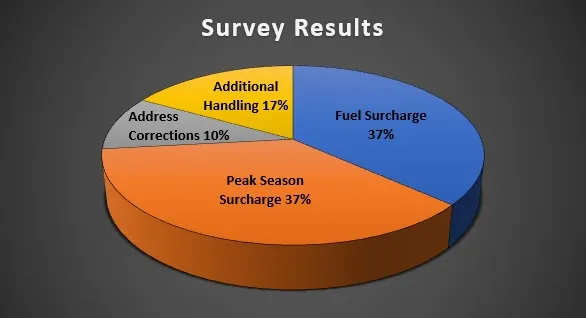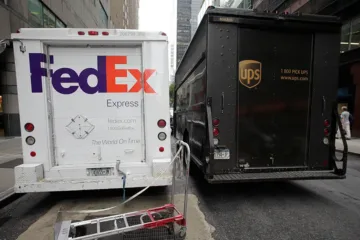Parcel Accessorial Charges
Parcel accessorial charges have a significant impact on shipping costs, especially for businesses relying on small parcel shipments. To gain further insights into this matter, we decided to conduct a survey with a focus on four frequently discussed Accessorial charges among shippers. The main objective of this survey was to determine which of these charges’ shippers would prefer to eliminate, given the chance. In this article, we will not only analyze the poll results but also provide actionable insights along with strategies to help businesses reduce shipping costs.
Survey Results and Key Takeaways:
Fuel Surcharge: 37%
Peak Season Surcharge: 37%
Address Corrections: 10%
Additional Handling: 17%

Shippers' Concerns
The survey results shed light on the shippers' concerns regarding accessorial charges. Notably, the high percentage of respondents selecting fuel surcharges and peak season surcharges demonstrates that rising shipping costs, especially during peak seasons, are significant worries for shippers. These charges, however, are predominantly controlled by the carriers, making it more challenging for shippers to directly influence or mitigate them.
Fuel surcharges are determined by carriers to account for fluctuating fuel prices. Similarly, peak season surcharges are implemented during periods of high demand, such as the holiday season, to manage the increased volume of shipments. Shippers, while concerned about these charges, may have limited avenues for reducing them. However, shippers can take proactive steps to navigate these challenges:
- Negotiating Contracts: By negotiating favorable contracts and engaging in open discussions with carriers, shippers can potentially secure better terms, including lower fuel surcharges and peak season rates. Building strong partnerships with carriers based on transparency and mutual understanding can result in more favorable pricing structures.
- Exploring Alternative Shipping Options: Shippers can conduct thorough market research to identify alternative carriers or shipping services that may offer more competitive rates and fewer accessorial charges. Comparing rates and terms from different providers can lead to cost-effective solutions, especially for shippers facing significant concerns with fuel surcharges and peak season surcharges.
On the other hand, the survey results indicate that shippers expressed relatively lower levels of concern regarding address corrections and additional handling charges. The lower level of concern regarding these charges signifies that shippers have more control over reducing their occurrences.

Address Corrections
Shippers expressed a relatively low concern regarding address corrections compared to other accessorial charges. However, businesses can still take steps to control and minimize address corrections, which can result in significant cost savings and help avoid delivery delays. By leveraging address validation and classification systems, shippers can enhance accuracy and streamline their shipping processes.
- Address Validation Systems: Implementing address validation systems is a crucial step in reducing address correction charges. These systems use real-time data verification to ensure that addresses are complete, accurate, and up-to-date. By integrating these tools into their shipping workflows, businesses can catch and correct address discrepancies before packages are shipped. This helps eliminate unnecessary charges caused by incorrect or incomplete addresses.
- Address Classification Systems: Another effective strategy is to utilize address classification systems. These systems automatically categorize addresses based on their deliverability. By classifying addresses as residential or commercial, for example, shippers can ensure that the appropriate shipping rates and surcharges are applied from the outset. This proactive approach minimizes the risk of address-related complications and helps prevent additional charges due to misclassified addresses.
- Collaboration with Customers: Open and clear communication with customers is essential to ensure accurate address information. Shippers can encourage customers to double-check the accuracy of their shipping addresses during the checkout process, reinforcing the importance of providing complete and error-free information. This collaborative effort reduces the likelihood of address correction fees and avoids unnecessary delays in delivery.
- Training and Quality Control: Investing in training programs and implementing quality control measures within the shipping and order fulfillment teams can help reduce errors related to address accuracy. By emphasizing the importance of accurate address entry and providing ongoing training on using address validation systems, businesses can minimize the occurrence of address correction issues. Regular quality checks can also ensure compliance with established shipping protocols and improve overall accuracy.
- Continuous Improvement and Feedback: It's crucial for shippers to solicit feedback from both customers and carriers to identify recurring address-related issues. This feedback loop can highlight areas where improvements can be made, such as addressing common errors or updating internal processes to prevent address correction charges. By actively seeking input and continuously improving their shipping operations, businesses can further minimize address correction fees and streamline their overall shipping process.

Additional Handling
Shippers who handle larger or fragile packages have consistently expressed their concerns about additional handling fees. To proactively address this issue, businesses can adopt innovative packaging and handling methods to minimize damage and lower associated costs. Implementing the following best practices can significantly reduce the likelihood of incurring additional handling charges, providing substantial cost savings in the long run.
- Reducing Air in Packages: One effective way to optimize packaging is by reducing excess air or wasted space within the parcels. Shippers can utilize appropriate packaging materials, such as bubble wrap or foam, to fill voids and secure items within the package. Minimizing unused space not only reduces the risk of damage but also helps decrease the dimensional weight of the shipment, potentially resulting in lower shipping costs.
- Vacuum Packaging, When Viable: For certain products that can withstand compression, vacuum packaging can be an excellent option. This method removes excess air from the package, reducing its overall size and providing better protection for the contents. Shippers should assess the feasibility and suitability of vacuum packaging for their specific products to maximize space utilization and minimize the need for additional handling.
- Nesting Products within Larger Items: When shipping multiple items together, nesting smaller items within larger ones can effectively optimize space and reduce the chances of damage. For example, placing smaller items inside larger containers or utilizing dividers to secure individual components can prevent shifting during transit, minimizing the risk of additional handling and associated fees.
- Downsizing While Enhancing Protection: Shippers can get creative and explore innovative approaches to reduce package sizes without compromising product safety. This may involve employing advanced packaging materials such as shock-resistant padding, custom foam molds, or inflatable cushions. Utilizing these protective measures allows for a smaller package size while ensuring adequate product safeguarding during transportation.

Actionable Insights for Shippers
To minimize accessorial charges and achieve cost reduction, consider the following strategies
Knowledge is Power: Stay informed about various accessorial charges to understand their impact on shipping costs. Regularly review carrier agreements and stay updated on industry trends to make informed decisions.
Shop around: Compare rates and accessorial charges offered by different carriers. Opt for carriers that provide competitive rates and offer fewer accessorial charges. Obtaining quotes from multiple carriers ensures that businesses make the most cost-effective choice.
Collaboration with Carriers: Work closely with carriers to develop strategies aimed at minimizing accessorial charges. For instance, consider pre-sorting packages to reduce the need for address corrections. Additionally, collaborate on plans for handling larger or fragile packages to minimize the risk of damage and extra fees. Transparent communication with carriers enables mutually beneficial solutions.

Additional Survey Insights
Rising Shipping Costs: The survey results align with the overall trend of increasing shipping costs, emphasizing the need for cost reduction in other controllable areas. Businesses should proactively seek opportunities to optimize their shipping operations.
Importance of Understanding Accessorial Charges: The results underscore the significance of comprehending different accessorial charges and their implications for shipping costs. By being aware of these charges, shippers can actively seek ways to reduce costs and negotiate better contracts with carriers.
In conclusion: The survey results reveal valuable insights into shippers' concerns and trends regarding small parcel shipping costs. By utilizing the actionable insights provided, businesses can enhance their shipping operations, decrease expenses, and improve overall efficiency. Remember to foster transparent communication with carriers and work collaboratively to minimize accessorial charges, ultimately delivering cost-effective shipping solutions.



